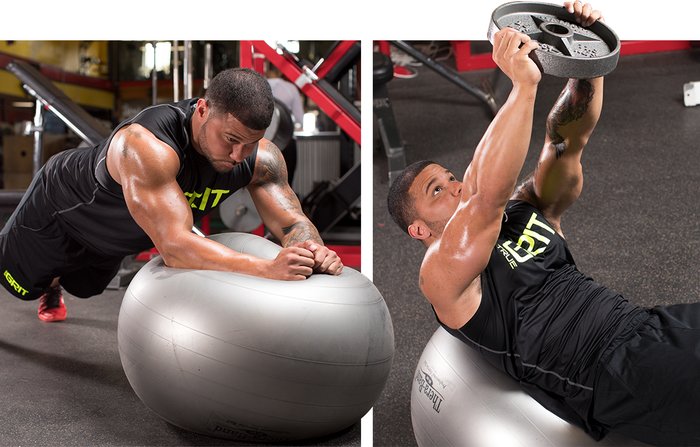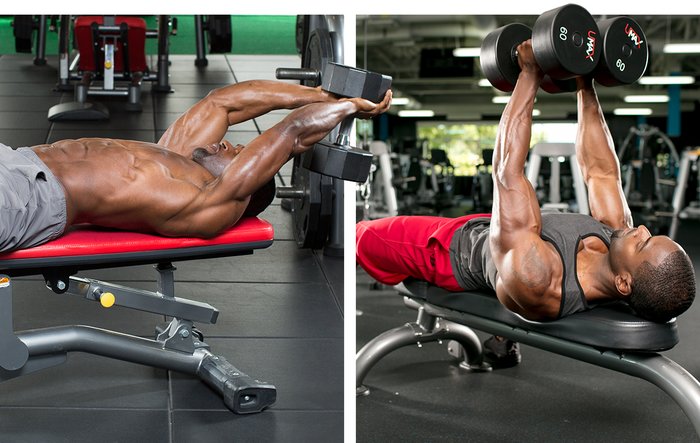There's nothing at all wrong with straight sets. You can use them effectively to get seriously big and strong—if you have the time. But even if you do just a few selective paired sets here and there, it can make a huge difference.
What's a paired set? Think of it as a superset, but without the frantic "no rest" mindset. Instead, you rest as much as you need to, but no longer. There are plenty of unique pairings in the popular True Muscle program I created for Bodybuilding.com, but I've found many others over the years.
If you're into the scientific evidence on why paired sets are great, a 2010 study published in the Journal of Strength and Conditioning Research investigated the acute effects of performing paired-set vs. traditional-set protocols over three consecutive sets in trained men. This research concluded that paired-set training may be more effective than traditional-set training at enabling lifters to handle maximum volume in their workout. The researchers suggested that anyone who wants to maximize work and minimize time should try it.[1]
Here are six of my favorites. Slot them into your workouts and you won't be disappointed.
1. Romanian Deadlifts With Arm Walk-outs
Lower-body/upper-body paired sets are a common—and effective—way to train. That said, I also like to pair up lower-body exercises with abdominal exercises.
Many common compound exercises like squats and deadlifts work the heck out of the posterior core muscles, but they don't do as much as you think—or as some people will tell you— for your abdominal muscles.
You probably don't have anything to gain from, say, pairing max-effort single-rep deads with high-rep crunches. But a solid accessory move like Romanian deadlifts, done for sets of at least 6-8 reps, pair nicely with anterior core work.
Perform a set of Romanians, rest as needed, then perform a set of arm walk-outs. These are just like ab roll-outs, but sneakily tougher since you walk your hands out rather than rolling. You can also use a medicine ball walk-out, which I had Steve Weatherford perform in the True Muscle video workouts.
2. Triceps Rope Press-down With Face Pull

This is a great paired set if you have an arms and shoulders day in your training split. Plus, this pair works really well because both exercises involve the rope attached high on the cable column.
Go for the pump on both, get your accessory work out of the way, and walk out of the gym with a wicked pump. You know you want to.
3. Horizontal Presses With Side-Plank External Rotation
It's pretty common to do upper-body push/pull paired sets, and to be clear, I think that's a great strategy. But, since horizontal pressing exercises like bench presses, dumbbell presses, or machine presses all work the internal shoulder rotators, it's a no-brainer to pair these moves with targeted shoulder external rotation. Not to mention, shoulder external-rotation work is often lacking in many workout programs
Now, before you reach for two dumbbells and perform standing external rotations with your elbows bent at 90 degrees, stop! Biomechanically, this exercise is basically just an isometric biceps curl. Sure, you are internally and externally rotating your shoulder, but you're not sufficiently loading the rotator cuff muscles since they're moving horizontally or rotationally, and this exercise is loaded vertically by gravity.
To sufficiently load the external rotators of your shoulder, you have to create a horizontal load vector by using a cable or band that's set at roughly the same height as your elbow. One way to do this is to perform standing cable external rotations. You can also lie on your back and perform cable rotations, a technique I demonstrate in the video workout "The Gritty Workout Your Upper Body Needs."
My favorite way, however, is to perform external rotations with a dumbbell while side-lying or in a side-plank position. These are far, far tougher than they look!
4. Stability Ball Arch With Plate Crunch

The ball arch may look suspiciously like another popular core exercise, stir the pot, but there's a big difference. Making full circles on the ball is, in my experience, unnecessary and awkward when your arms are close in. Eliminating the bottom end of the circle—i.e., doing arches instead of stir the pot—takes away the part of the exercise where your arms are fully underneath you. That is the easiest portion of the exercise on your abs, but the most awkward on your shoulders. So, the arch is harder, but less prone to aggravating delicate shoulders.
To perform the ball arches, place both forearms on top of a fitness ball and assume a plank position with your body in a straight line and your feet just farther than shoulder-width apart. Alternate between left-to-right arches and right-to-left arches, without allowing your head or hips to sag toward the floor. Reach your arms as far as you can without feeling discomfort in your lower back.
The second exercise is plate crunches, which involve reaching a weight-plate to the sky as you move over the ball. Don't let the ball move! Bend over it, rather than letting it roll around. Keep your knees at 90 degrees throughout the movement.
5. Back Row With Horizontal Scapular Shrug
In my article "The Six Grittiest Back Exercise You're Not Doing," I discussed combining partial range of motion rep sets with full range of motion sets. It's an incredibly effective approach, and this pairing helps you use it for your upper back.
In this paired set, you begin by performing a set of two-arm horizontal rows. They could be dumbbell rows, barbell rows, seated rows, T-bar rows, machine rows, or pretty much any other row variation. Check out my article "The Complete Guide to Rows" for plenty of other variations to choose from.
Once you can no longer complete the reps you set out to do in good technique, go right into a horizontal scapular shrug by pinching your blades together, then letting them spread apart. If it helps you "feel" this move better, you can also perform the top third of a row by bending your elbows a bit as you pinch your shoulder blades. Then, when you straighten your arms you also simultaneously allow you shoulder to protract as far as possible.
6. Chest-Tri Dumbbell Superset
There are three permutations of this paired set, each performed with a dumbbell in each hand while lying supine on a bench. More than any of the other pairings above, these are great to perform superset-style, with little to no rest between.

- Version 1: Superset dumbbell chest flyes with dumbbell squeeze presses. So, once you've hit your limit on flyes, squeeze the dumbbells together hard and press them.
- Version 2: Superset dumbbell pull-overs with dumbbell squeeze presses.
- Version 3: Superset dumbbell skullcrushers with dumbbell pull-overs.
Of course, you could also do a triset of three of these moves. For example, you could perform a set of dumbbell chest flyes immediately followed by a set of dumbbell pull-overs, immediately followed by a set of dumbbell squeeze presses.
If you really wanted to, you could even perform a giant set of all four of these moves: dumbbell chest flyes, pull-overs, skullcrushers and squeeze presses. Now that's a solid way to end a chest day!
Keep Logistics in Mind!
You may or may not have noticed this already, but all of the paired sets and supersets highlighted in this article have been designed with the big-box gym member in mind. In other words, they each either involve using the same piece of equipment, or they group exercises requiring immobile equipment—e.g., a bench press—with exercises using mobile equipment—e.g., dumbbells or resistance bands.
This mixture enables you to bring the mobile equipment to the immobile equipment and remain there without having to walk all over the gym, lose the equipment you're using to another member, or hog multiple stations. You can use this same strategy when designing your own paired sets and supersets.
Here's to more efficient, effective, and gritty training.
References
- Robbins, D. W., Young, W. B., & Behm, D. G. (2010). The effect of an upper-body agonist-antagonist resistance training protocol on volume load and efficiency. The Journal of Strength & Conditioning Research, 24(10), 2632-2640.

